Artist Diary: Brandon Ballengée Dives Into the Aftermath of the Deepwater Horizon Oil Spill

Searching for the Ghosts of the Gulf (African Pompano) by Brandon Ballengée, 2014.
Brandon Ballengée, artist and biologist, was spurred to action by the 2010 Deepwater Horizon oil spill—the largest oil spill in human history which lasted for almost four months and contaminated the Gulf of Mexico with an estimated 200 million gallons of crude oil. Experts believe that half of this oil remains in the Gulf, continuing to impact deep water habitats and species.
Ballengée’s 2019 Creative Capital project, Searching for the Ghosts of the Gulf, is an interdisciplinary art and environmental project seeking to activate and empower Gulf of Mexico residents through eco-actions and pop-up exhibitions in coastal Louisiana. As part of the work, Ballengée searches for and poetically portrays “missing” Gulf species that have not been reported since the spill. Dive into his Artist Diary and learn about the making of this multi-tentacled project.
Searching for the Ghosts of the Gulf will make its public premiere as part of FishSTOCK, a community celebration of art, adaptation, and fishes, in Plaquemines Parish, LA on March 25, 2023.
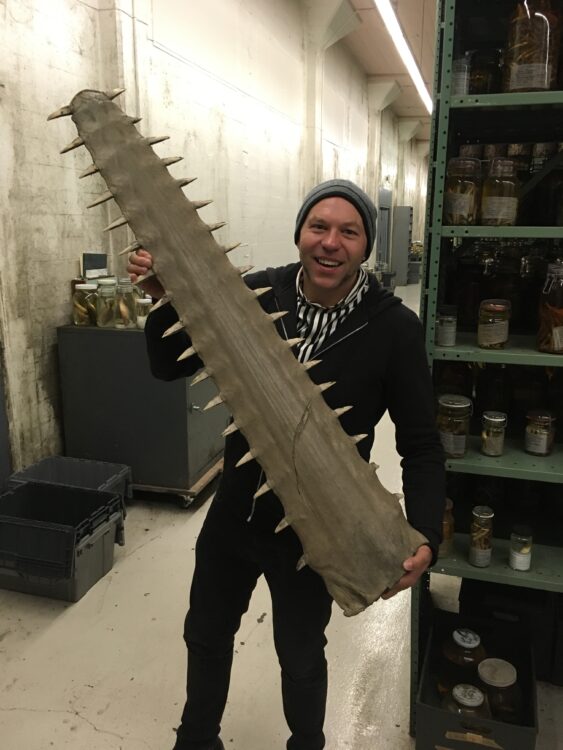
Holding the largest sawfish bill I have ever seen at TUBRI’s Royal D. Suttkus Fish Collection. Once common in the Gulf of Mexico, sawfish are now critically endangered. Photo by Cammie Hill-Prewitt.
I am both an artist and a biologist. As a biologist, I am an amphibian specialist working in a fish lab at Tulane University. As an artist, I am constantly inspired by nature. And as an environmental advocate, I want my art and science to inspire people about the diversity of life on this wonderful tiny planet.
In this picture, I am at Tulane University Biodiversity Research Institute’s (TUBRI) Royal D. Suttkus Fish Collection, the largest preserved fish collection in the world located in several converted World War II bunkers in Belle Chasse, Louisiana.
As part of my project, I became TUBRI’s first ever Artist in Residence and an Adjunct Faculty of Ecology and Evolutionary Biology.
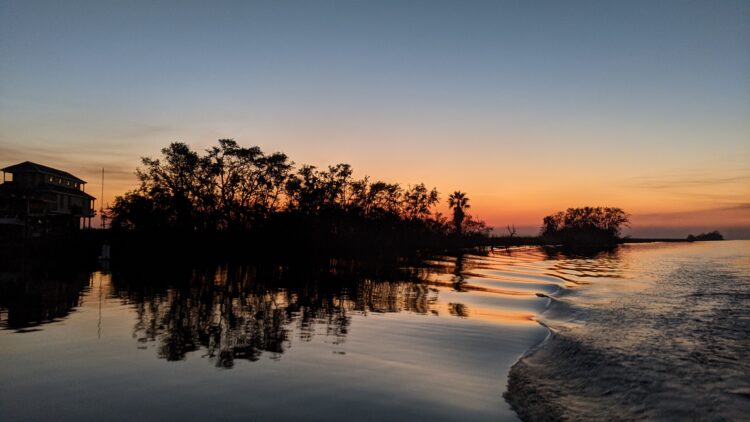
Cypremort Point, Louisiana, November 2020. Photo by Brandon Ballengée.
South Louisiana is special for many reasons including our rich mix of cultures, including Native American, Creole, Cajun and others. We are a slow cooked gumbo of peoples and traditions. Much of the land itself is a former delta and remarkably rich, and this is reflected in our immense terrestrial biodiversity.
The Gulf of Mexico is a highly productive environment and nursery for thousands of species. It’s also the home to thousands of shrimpers, and other fisher folk that rely on this not only as a source of income for commercial fishing, but also as a vital source of food, including indigenous populations that still live in these wetlands in villages that you can only get to by boat.
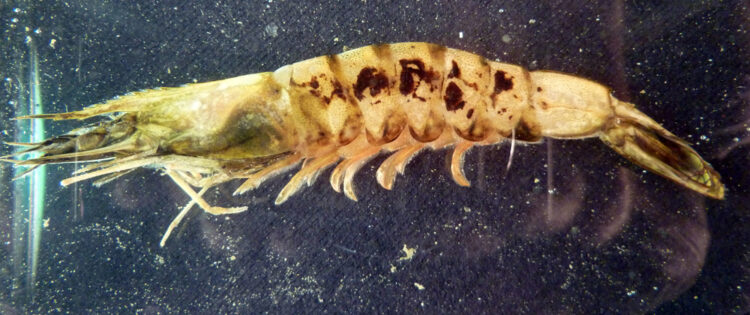
Shrimp specimen with oil under shell collected from the Gulf of Mexico in the fall 2012. Photo by Brandon Ballengée.
This project really started with the 2010 Deepwater Horizon, the largest oil spill in human history. It lasted for almost four months and contaminated the Gulf with an estimation of over 200 million gallons of crude oil. It is estimated that almost half this oil remains in the Gulf, continuing to impact deep water habitats and species.
Even more than a decade later we are still trying to understand the impacts of the Deepwater Horizon spill on Gulf communities, species, and ecosystems.

Gulf of Mexico endemic fishes “missing” since the 2010 spill. This poster has been given away during outreach events and posted in marinas, schools, groceries, the Louisiana State Senate and other public venues. Photo by Brandon Ballengée.
As a scientist in 2016, I began research into Gulf of Mexico fish and potential oil spill impacts on them through a postdoc at Louisiana State University. As part of a team at the LSU’s Museum of Natural Science, we have examined natural history records of the endemic Gulf fishes five years before the Deepwater Horizon oil spill (2010) and five years after. We found that fourteen endemic species (not found anywhere else on the planet) were “missing” from the records and had not been reported after the spill. Additionally, several other Gulf endemics have been “missing” for decades.
This research was the foundation for the current project, Searching for Ghosts of the Gulf.
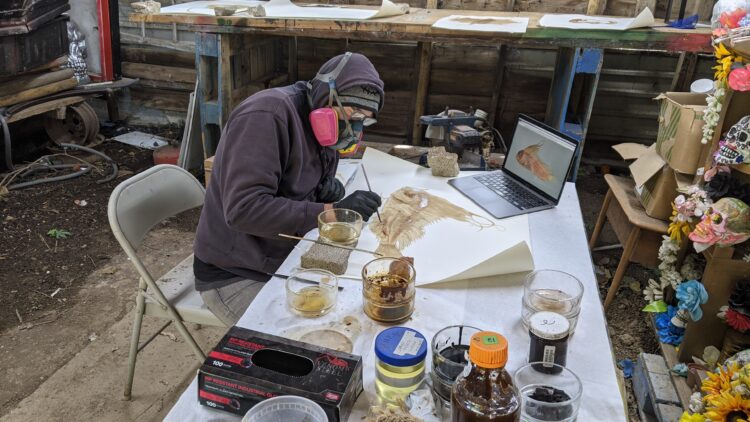
Painting with crude oil, December 2020. Photo by Aurore Ballengée.
Since the project is heavily focused on public outreach, it was significantly impacted and delayed by the COVID-19 crisis and hurricane Ida (2021).
However, it gave me time to focus on creating new works, like this “Crude Oil Painting”, from a series of ten, created with source oil from Deepwater Horizon, or from ‘fresh’ crude oil from the ongoing Taylor/ MC20 spill (the longest running oil spill in US history 2004-ongoing), contaminated marshland sediment with oil, anaerobic bacteria and iron oxide mixed with COREXIT 9500A (dispersant).
When I’m working with this material, I use safety materials to be able to breathe safely, but the unfortunate side is, this is in our environment here, it’s in our food chain. It is mixed into our marsh islands, it’s mixed into the substrate of the gulf. So it is still prevalent.
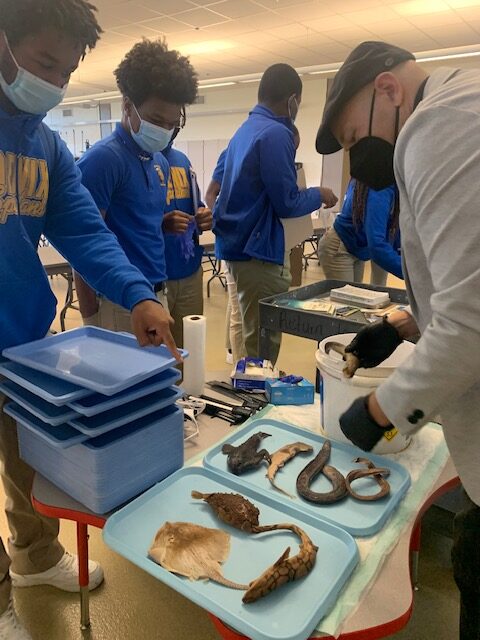
Fish Adaptation Workshop at Phoenix High School Phoenix, Louisiana, December 2021.
Thanks to Creative Capital support and an NEA “Our Town” grant in partnership with A Studio in the Woods (New Orleans, LA) and the Plaquemines Parish Government (South of New Orleans), I was able to work with communities from the part of the world that is losing land at the most rapid place on the planet.
These folks are very rural, isolated, and have a lot of challenges when it comes to climate change. They have a strong cultural connection to the land but the land is disappearing. Many don’t have the means to leave, but most will be forced to leave because of the impact of stronger hurricanes, sinking land and sea level rise. They are themselves truly culturally endangered.
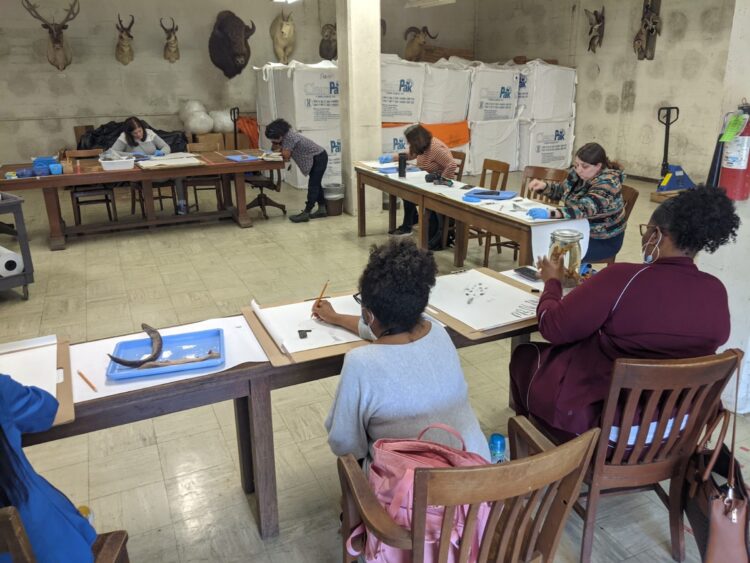
Fish Drawing Professional Development workshop at TUBRI’s Royal D. Suttkus Fish Collection, December 21. Photo by Brandon Ballengée.
I started offering fish drawing workshops to school students, teachers and the community at large (including fishermen and oil industry workers) to talk about adaptation through art and science.
Fishes are by far the most successful group of vertebrates—animals with backbones—to ever occupy Earth. Fish are marvels of adaptation and resilience, occupying almost all bodies of water on our planet, and there are nearly 35,000 described species with new species being found all the time. Evidence has shown some fishes can adapt to numerous environmental stressors,
Participants in the workshops are encouraged to look and sketch fish specimens while we discuss their evolutionary adaptations. The fundamental questions posed by the workshops is what we can learn from fishes about changes to our communities and environment and how we might adapt to these.
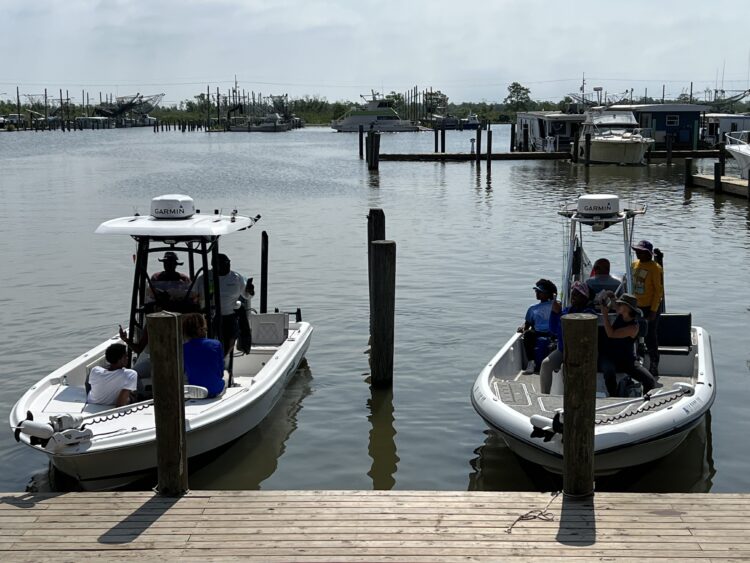
Fishing trip with Plaquemines Parish high school students, Venice Marina, May 2022. Photo by Brandon Ballengée.
I also took a group of high school students on a journey to look for “Ghosts of the Gulf”.
Despite being surrounded by water and coming from families of fisherfolks, many of these kids had never been on a boat trip. In most cases, their family’s boats had been destroyed by hurricanes in years past.
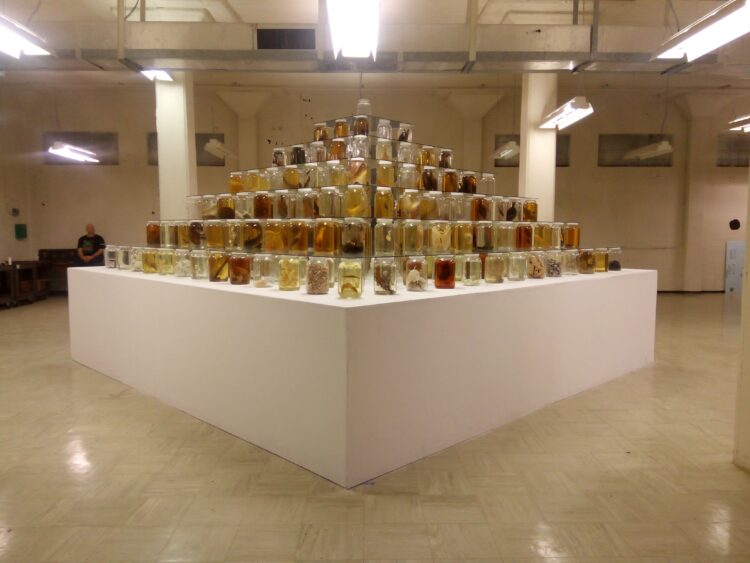
Collapse, installed at TUBRI’s Royal D. Suttkus Fish Collection, Mars 2023. Photo by Brandon Ballengée.
After more than four years of work, my project premiere will take place as a community-based pop-up exhibition at Tulane University’s Royal D. Suttkus Fish Collection.
Here I will exhibit my monumental installation Collapse and other artworks created during my Searching for Ghosts of the Gulf project, as well as participant artworks made during my community and school programs.
This is a major achievement for me, as exhibiting Collapse in New Orleans has proved impossible, due to most of the arts funding coming from the oil and gas industry.

FishSTOCK poster, March 2023.
We will also inaugurate a new festival focused on Plaquemines Parish community resilience, adaptation and the natural resources that make this part of the world so special. “Collapse” and many of the artworks to be exhibited responded to the 2010 Deepwater Horizon oil spill. Showing the work in Plaquemines Parish is important because it is the parish that was the most heavily impacted from that spill and continues to be impacted from the ongoing Taylor Energy spill (2004-ongoing, the longest oil spill in US History). Additionally, the communities here are at the front line of climate change with land loss occurring at the most rapid rate on the planet, increased flooding and stronger storms, and more
Brandon Ballengée’s Searching for the Ghosts of the Gulf will premiere at FishSTOCK in Plaquemines Parish, LA on March 25, 2023 from 11:00AM–4:00PM.
